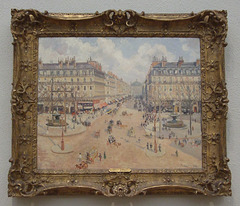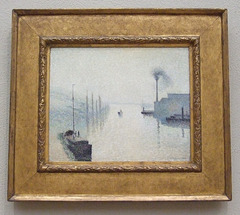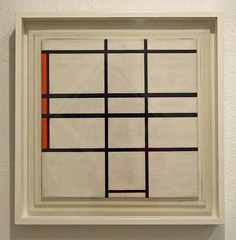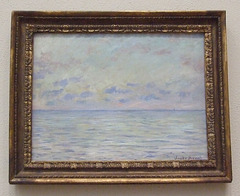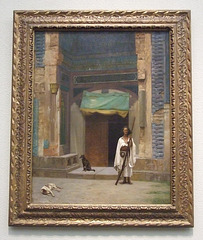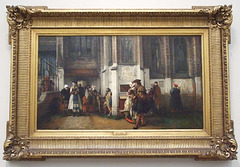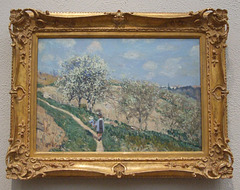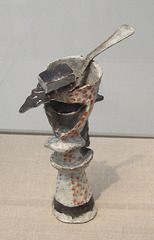
Philadelphia Museum of Art
Avenue de l'Opera, Morning Sunshine by Pissarro in…
| |
|
Avenue de l'Opéra: Morning Sunshine
Camille Pissarro, French, 1830 - 1903
Geography: Made in France, Europe
Date: 1898
Medium: Oil on canvas
Dimensions: 26 x 32 1/4 inches (66 x 81.9 cm)
Curatorial Department: European Painting before 1900, Johnson Collection
Object Location: Gallery 152, European Art 1850-1900, first floor (Toll Gallery)
Accession Number: 1991-180-2
Credit Line: Partial and promised gift of an anonymous donor, 1991
Text from: www.philamuseum.org/collections/permanent/86418.html?mulR=305996642|1
L'Ile Lacroix, Rouen by Pissarro in the Philadelph…
| |
|
Detail of the Portrait of Emilie Ambre as Carmen b…
| |
|
Portrait of Émilie Ambre as Carmen
Édouard Manet, French, 1832 - 1883
Geography: Made in France, Europe
Date: 1880
Medium: Oil on canvas
Dimensions: 36 3/8 x 28 15/16 inches (92.4 x 73.5 cm) Framed: 48 1/8 x 40 x 3 1/2 inches (122.2 x 101.6 x 8.9 cm)
Curatorial Department: European Painting before 1900, Johnson Collection
Object Location: Gallery 153, European Art 1850-1900, first floor (Lassin Gallery)
Accession Number: 1964-114-1
Credit Line: Gift of Edgar Scott, 1964
Additional information:
Publication- Masterpieces from the Philadelphia Museum of Art: Impressionism and Modern Art
A celebrity in her day, Émilie Ambre (1854-1898) came from a wealthy North African family and was the mistress of King William III of the Netherlands prior to pursuing a career as an opera singer. Manet met Ambre in the summer of 1879 at a spa outside Paris where he was seeking treatment for a reoccurring leg ailment. In Manet's portrait, the singer appears in Spanish costume as Carmen, the tragic gypsy heroine of Georges Bizet's opera. A popular story set in Seville, and filled with bullfighters, smugglers, and dancers, Carmen was nevertheless controversial because its heroine was not a pure or chaste woman but one who led her unsuspecting lover into a life of crime and was murdered by him. With her dark features and celebrated past, Ambre was well suited for the part of Carmen, a role she played on tours in the United States in 1879 and 1880. The harsh side lighting in the portrait suggests the stage, although the painting, with its plain background, does not illustrate an identifiable moment in the opera. Ambre's clothing and the fan in her left hand are rapidly sketched in broad, assured brushstrokes that signal Manet's own bravura performance. Jennifer A. Thompson, from Masterpieces from the Philadelphia Museum of Art: Impressionism and Modern Art (2007), p. 52.
Text from: www.philamuseum.org/collections/permanent/59866.html?mulR=1861523577|1
Portrait of Emilie Ambre as Carmen by Manet in the…
| |
|
Portrait of Émilie Ambre as Carmen
Édouard Manet, French, 1832 - 1883
Geography: Made in France, Europe
Date: 1880
Medium: Oil on canvas
Dimensions: 36 3/8 x 28 15/16 inches (92.4 x 73.5 cm) Framed: 48 1/8 x 40 x 3 1/2 inches (122.2 x 101.6 x 8.9 cm)
Curatorial Department: European Painting before 1900, Johnson Collection
Object Location: Gallery 153, European Art 1850-1900, first floor (Lassin Gallery)
Accession Number: 1964-114-1
Credit Line: Gift of Edgar Scott, 1964
Additional information:
Publication- Masterpieces from the Philadelphia Museum of Art: Impressionism and Modern Art
A celebrity in her day, Émilie Ambre (1854-1898) came from a wealthy North African family and was the mistress of King William III of the Netherlands prior to pursuing a career as an opera singer. Manet met Ambre in the summer of 1879 at a spa outside Paris where he was seeking treatment for a reoccurring leg ailment. In Manet's portrait, the singer appears in Spanish costume as Carmen, the tragic gypsy heroine of Georges Bizet's opera. A popular story set in Seville, and filled with bullfighters, smugglers, and dancers, Carmen was nevertheless controversial because its heroine was not a pure or chaste woman but one who led her unsuspecting lover into a life of crime and was murdered by him. With her dark features and celebrated past, Ambre was well suited for the part of Carmen, a role she played on tours in the United States in 1879 and 1880. The harsh side lighting in the portrait suggests the stage, although the painting, with its plain background, does not illustrate an identifiable moment in the opera. Ambre's clothing and the fan in her left hand are rapidly sketched in broad, assured brushstrokes that signal Manet's own bravura performance. Jennifer A. Thompson, from Masterpieces from the Philadelphia Museum of Art: Impressionism and Modern Art (2007), p. 52.
Text from: www.philamuseum.org/collections/permanent/59866.html?mulR=1861523577|1
Composition with White and Red by Mondrian in the…
| |
|
The True Artist Helps World by Revealing Mystic Tr…
| |
|
The True Artist Helps the World by Revealing Mystic Truths (Window or Wall Sign)
Bruce Nauman, American, born 1941
Date: 1967
Medium: Neon
Dimensions: 59 x 55 x 2 inches (149.9 x 139.7 x 5.1 cm)
Copyright: © Bruce Nauman / Artists Rights Society (ARS), New York
Curatorial Department: Contemporary Art
Object Location: Gallery 170, Modern and Contemporary Art, first floor
Accession Number: 2007-44-1
Credit Line: Purchased with the generous support of The Annenberg Fund for Major Acquisitions, the Henry P. McIlhenny Fund, the bequest (by exchange) of Henrietta Meyers Miller, the gift (by exchange) of Philip L. Goodwin, and funds contributed by Edna Andrade, 2007
Label:
The True Artist Helps the World by Revealing Mystic Truths (Window or Wall Sign), one of Nauman’s first neons, is a founding work in his career. Hijacking a medium generally associated with the tawdry (cheap motels, shop windows, and bars), Nauman's sign advertises a metaphysical and deeply personal message as if it were for sale. Throughout his long and illustrious career, Nauman has examined the role and responsibilities of the artist. The title statement of this poetic spiral is neither entirely facetious nor completely serious, and the contradictions embodied in the piece yield an ambiguity that is both playful and profound.
Additional information:
Publication- Philadelphia Museum of Art: Handbook of the Collections
Over the past four decades, Bruce Nauman has become a cornerstone of contemporary artistic practice through his maverick use of mediums--encompassing photography, neon, film and video, installation, drawing, sculpture, and printmaking--and his continual investigation into often paradoxical and conceptual uses of language and the body. In 1967, Nauman had recently completed his MFA at the University of California, Davis, and was newly cast into the world as young artist pondering his role in society. A relic of his San Francisco street-level studio's former capacity as a grocery store-a still-functioning neon beer sign-propelled Nauman's creation of this seminal Window or Wall Sign, which he hung in the window facing the street. By commandeering the commercial medium of neon for an artist statement, Nauman both proclaims the importance of the "true artist's" role and implies its inherent quixotic ambition. At once forward and facetious, lofty and self-aware, Window or Wall Sign asks its reader to participate in determining the validity of its declaration. Erica Battle, from Philadelphia Museum of Art: Handbook of the Collections, 2009.
Text from: www.philamuseum.org/collections/permanent/31965.html?mulR=2052452676|2
Detail of At the Moulin Rouge- The Dance by Toulou…
| |
|
At the Moulin Rouge: The Dance
Henri de Toulouse-Lautrec, French, 1864 - 1901
Geography: Made in Paris, France, Europe
Date: 1890
Medium: Oil on canvas
Dimensions: 45 1/2 x 59 inches (115.6 x 149.9 cm)
Curatorial Department: European Painting before 1900, Johnson Collection
Object Location: Gallery 165, European Art 1850-1900, first floor (Eglin Gallery)
Accession Number: 1986-26-32
Credit Line: The Henry P. McIlhenny Collection in memory of Frances P. McIlhenny, 1986
Additional information:
Publication- Philadelphia Museum of Art: Handbook of the Collections
A recently discovered penciled inscription, in the artist's hand, on the back of this famous painting reads: "The instruction of the new ones by Valentine the Boneless." Henri de Toulouse-Lautrec was thus not depicting an ordinary evening at the Moulin Rouge, the fashionable Parisian nightclub but rather a specific moment when a man now known only by his nickname (which certainly describes his nimbleness as a dancer) appears to be teaching the "can-can." Many of the inhabitants of the scene are well-known members of Lautrec's demimonde of prostitutes and artists and people seen only at night including the white-bearded Irish poet William Butler Yeats who leans on the bar. One of the mysteries, however, is the dominant woman in the foreground, the beauty of her profile made all the more so in comparison with that of her chinless companion. It is the latter who expresses better than nearly any other character in this full stage of people Lautrec's profoundly touching ability to be brutally truthful but also truly kind in his observations. Joseph J. Rishel, from Philadelphia Museum of Art: Handbook of the Collections (1995), p. 206.
Provenance: Joseph Oller, Paris, 1890, until at least 1893. With Paul Rosenberg, Paris [1]; S. Sévadjian; his sale, [as M. S... S...], Hôtel Drouot, March 22, 1920, no. 17; purchased by Arnold Seligmann of Arnold Seligmann & Cie., Paris, and still in 1925 [2]. ?With Paul Rosenberg, by 1926 [3]; with Arnold Seligmann & Cie., Paris, by 1928, to 1934 [4]; Seligmann estate, as of February 1934 [5]; sold to Henry P. McIlhenny, Philadelphia (possibly via Jacques Seligmann & Co.), by June 1934 [6]; bequest to PMA, 1986. 1. Per M. G. Dortu, Toulouse-Lautrec et son oeuvre, vol. 2, New York, 1971, no. P.361. Oller and Charles Zidler were co-owners of the Moulin Rouge in Paris. Zidler, the Moulin Rouge director, placed the painting on permanent exhibit there from 1890-1893. See Richard Thomson, Toulouse-Lautrec (exh. cat., Hayward Gallery, 1991), pp. 229, 246. 2. Clipping (Gazette de l'Hôtel Drouot) and annotation in Getty copy of sale catalogue. Arnold Seligmann was the lender to the exhibition Paris, Musée des Arts Décoratifs, "Cinquante ans de peinture française, 1875-1925," May 28-July 12, 1925, no. 77. 3. Rosenberg is listed as the owner in Maurice Joyant, Henri de Toulouse-Lautrec, 1864-1901, Paris, 1926, p. 268. Possibly a mistake based on Rosenberg's earlier ownership, as Seligmann is documented as owner in 1925 and from 1928-1934. 4. Seligmann loaned the painting to a 1928 Paris exhibition (see also partial label on reverse). 5. The painting was lent to the exhibition "Paintings and Drawings by Toulouse-Lautrec," London, M. Knoedler & Co., February 1-21, 1934, by the Seligmann estate. 6. McIlhenny lent the painting to the PMA in June 1934. He writes in a letter to Martin Birnbaum dated July 17, 1934 (copy in curatorial file) that he had recently acquired the painting from the estate of Arnold Seligmann. In a letter to his insurance agent dated May 6, 1935 (copy in curatorial file), McIlhenny states that the painting was purchased from the dealer Jacques Seligmann (the firm founded by Arnold Seligmann's brother, who died in 1923), who presumably acquired it from the Arnold Seligmann estate.
Text from: www.philamuseum.org/collections/permanent/82776.html?mulR=111439228|1
Marine View Near Etretat by Monet in the Philadelp…
| |
|
Marine near Étretat
Claude Monet, French, 1840 - 1926
Geography: Made in France, Europe
Date: 1882
Medium: Oil on canvas
Dimensions: 21 1/2 x 29 1/16 inches (54.6 x 73.8 cm)
Curatorial Department: European Painting before 1900, Johnson Collection
Object Location: Gallery 152, European Art 1850-1900, first floor (Annenberg Galleries; Toll Gallery)
Accession Number: 1961-48-1
Credit Line: Bequest of Mrs. Frank Graham Thomson, 1961
Text from: www.philamuseum.org/collections/permanent/58673.html?mulR=1292248083|26
Under the Pines, Evening by Monet in the Philadelp…
| |
|
Under the Pines, Evening
Claude Monet, French, 1840 - 1926
Geography: Made in France, Europe
Date: 1888
Medium: Oil on canvas
Dimensions: 28 3/4 x 36 1/4 inches (73 x 92.1 cm)
Curatorial Department: European Painting before 1900, Johnson Collection
Object Location: Currently not on view
Accession Number: 1993-151-1
Credit Line: 125th Anniversary Acquisition. Gift of F. Otto Haas, and partial gift of the reserved life interest of Carole Haas Gravagno, 1993
Additional information:
Publication- Gifts in Honor of the 125th Anniversary of the Philadelphia Museum of Art
Claude Monet spent the first half of 1888 in Antibes on the French Riviera, where he continued to experiment with painting scenes under varying conditions of light. In this work, painted from the Cap d’Antibes, the artist has adroitly conveyed the evening glow of the Mediterranean Sea. The raking late-day light is fashioned from bright pastel strokes of pigment on the underside of the trees and the ground below, while the rich palette of the cool green treetops provides a striking contrast to the other high-keyed colors. The staccato rhythm of the brushstrokes in the trees creates an overall decorative pattern, invigorating the scene with a vitality that keeps the viewer’s eye moving across the surface of the image.
Monet’s work in Antibes would eventually lead to his famous series paintings, such as the “Haystacks” and the “Poplars,” both from the 1890s. However, unlike these later, more abstract compositions, there is a naturalistic sensibility in this painting, which emerges from the artist’s attention to detail with his use of intense color sensations.
At the Museum this work joins Morning at Antibes of 1888 (Philadelphia Museum of Art, 1978-1-22), and adds greater dimension to our substantial holdings of paintings by the artist. Indeed, this gift, together with Path on the Island of Saint Martin, Vétheuil, helps to confirm the Museum’s standing as one of the essential collections of Monet’s work. John Zarobell, from Philadelphia Museum of Art: Gifts in Honor of the 125th Anniversary (2002), p. 77.
Text from: www.philamuseum.org/collections/permanent/87534.html?mulR=493959882|5
Detail of The Portal of the Green Mosque by Gerome…
| |
|
Portal of the Green Mosque (Sentinel at the Sultan's Tomb)
Jean Léon Gérôme, French, 1824 - 1904
Geography: Made in France, Europe
Date: c. 1870
Medium: Oil on canvas
Dimensions: 28 1/4 x 22 1/4 inches (71.8 x 56.5 cm)
Curatorial Department: European Painting before 1900, Johnson Collection
Object Location: Gallery 155, European Art 1850-1900, first floor
Accession Number: 2007-29-1
Credit Line: Gift of the Isaacson-Draper Foundation, 2007
Text from: www.philamuseum.org/collections/permanent/100290.html?mulR=1819245498|2
The Portal of the Green Mosque by Gerome in the Ph…
| |
|
Portal of the Green Mosque (Sentinel at the Sultan's Tomb)
Jean Léon Gérôme, French, 1824 - 1904
Geography: Made in France, Europe
Date: c. 1870
Medium: Oil on canvas
Dimensions: 28 1/4 x 22 1/4 inches (71.8 x 56.5 cm)
Curatorial Department: European Painting before 1900, Johnson Collection
Object Location: Gallery 155, European Art 1850-1900, first floor
Accession Number: 2007-29-1
Credit Line: Gift of the Isaacson-Draper Foundation, 2007
Text from: www.philamuseum.org/collections/permanent/100290.html?mulR=1819245498|2
Detail of Faust and Marguerite by Leys in the Phil…
| |
|
Faust and Marguerite
Hendrik Jan August Leys, Belgian, 1815 - 1869
Geography: Made in Antwerp, Belgium, Europe
Date: 1856
Medium: Oil on panel
Dimensions: 39 1/4 x 69 3/4 inches (99.7 x 177.2 cm)
Curatorial Department: European Painting before 1900, Johnson Collection
Object Location: Gallery 155, European Art 1850-1900, first floor (Annenberg Galleries)
Accession Number: E1924-3-83
Credit Line: The William L. Elkins Collection, 1924
Label:
This painting shows a moment in Goethe's dramatic poem Faust.
Faust stands with the demonic Mephistopheles behind an iron screen, and he first spies the chaste Marguerite emerging from a church. Faust demands that Mephistopheles secure Marguerite's love for him. Leys has followed Goethe's description in his depiction of Marguerite as a young woman of modest or lower social standing with red lips, glowing cheeks, and downcast eyes.
Like many nineteenth-century artists, Leys was interested in the Middle Ages. Here he dresses the characters in medieval costume and sets the scene at a medieval cathedral in Antwerp, Belgium.
Text from: www.philamuseum.org/collections/permanent/102947.html?mulR=28282219|7
Detail of Faust and Marguerite by Leys in the Phil…
| |
|
Faust and Marguerite
Hendrik Jan August Leys, Belgian, 1815 - 1869
Geography: Made in Antwerp, Belgium, Europe
Date: 1856
Medium: Oil on panel
Dimensions: 39 1/4 x 69 3/4 inches (99.7 x 177.2 cm)
Curatorial Department: European Painting before 1900, Johnson Collection
Object Location: Gallery 155, European Art 1850-1900, first floor (Annenberg Galleries)
Accession Number: E1924-3-83
Credit Line: The William L. Elkins Collection, 1924
Label:
This painting shows a moment in Goethe's dramatic poem Faust.
Faust stands with the demonic Mephistopheles behind an iron screen, and he first spies the chaste Marguerite emerging from a church. Faust demands that Mephistopheles secure Marguerite's love for him. Leys has followed Goethe's description in his depiction of Marguerite as a young woman of modest or lower social standing with red lips, glowing cheeks, and downcast eyes.
Like many nineteenth-century artists, Leys was interested in the Middle Ages. Here he dresses the characters in medieval costume and sets the scene at a medieval cathedral in Antwerp, Belgium.
Text from: www.philamuseum.org/collections/permanent/102947.html?mulR=28282219|7
Faust and Marguerite by Leys in the Philadelphia M…
| |
|
Faust and Marguerite
Hendrik Jan August Leys, Belgian, 1815 - 1869
Geography: Made in Antwerp, Belgium, Europe
Date: 1856
Medium: Oil on panel
Dimensions: 39 1/4 x 69 3/4 inches (99.7 x 177.2 cm)
Curatorial Department: European Painting before 1900, Johnson Collection
Object Location: Gallery 155, European Art 1850-1900, first floor (Annenberg Galleries)
Accession Number: E1924-3-83
Credit Line: The William L. Elkins Collection, 1924
Label:
This painting shows a moment in Goethe's dramatic poem Faust.
Faust stands with the demonic Mephistopheles behind an iron screen, and he first spies the chaste Marguerite emerging from a church. Faust demands that Mephistopheles secure Marguerite's love for him. Leys has followed Goethe's description in his depiction of Marguerite as a young woman of modest or lower social standing with red lips, glowing cheeks, and downcast eyes.
Like many nineteenth-century artists, Leys was interested in the Middle Ages. Here he dresses the characters in medieval costume and sets the scene at a medieval cathedral in Antwerp, Belgium.
Text from: www.philamuseum.org/collections/permanent/102947.html?mulR=28282219|7
Landscape by Sisley in the Philadelphia Museum of…
| |
|
Detail of Maternal Caress by Mary Cassatt in the P…
| |
|
Maternal Caress
Mary Stevenson Cassatt, American, 1844 - 1926
Date: c. 1896
Medium: Oil on canvas
Dimensions: 15 x 21 1/4 inches (38.1 x 54 cm)
Curatorial Department: European Painting before 1900, Johnson Collection
Object Location: Gallery 111, American Art, first floor
Accession Number: 1970-75-2
Credit Line: Bequest of Aaron E. Carpenter, 1970
Label:
Mary Cassatt spent most of her life and career in France, where she was an active member of elite social and artistic circles. In the late 1870s she forged friendships with innovative painters including Camille Pissarro and Edgar Degas, becoming the only American to be officially associated with the Impressionists. At the end of the nineteenth century, many artists turned to the "mother and child" theme as an updated version of the Madonna and child, but Cassatt made it her specialty. Through her experiments with painting, pastel, and printmaking, she captured the daily lives of women and children, uniting a traditional subject with new artistic techniques. Later works such as Maternal Caress often focus on the child, demonstrating Cassatt's sensitive observation of young people growing up in a modern world.
Additional information:
Publication- Masterpieces from the Philadelphia Museum of Art: Impressionism and Modern Art
In the 1890s, Mary Cassatt grew dissatisfied with the Impressionist goal of rendering a purely physical world and, along with Puvis de Chavannes and Paul Gauguin, embraced a style of painting called Neo-Traditionism, which married realism with subjects having symbolic or allegorical meaning. Deeply influenced by her study of Old Master paintings in the Musée du Louvre and by several trips to Italy, Cassatt admired the layers of meaning in Renaissance art and sought to bring similar content to contemporary painting. Maternal Caress, in which the subjects are framed to emphasize their large rounded forms and to limit external distractions, recalls medieval and Renaissance compositions of the Madonna and Child. Cassatt has increased the sense of intimacy between mother and child by shifting the perspective over the mother's shoulder. The painting followed an important commission for a large-scale mural (now lost) devoted to the subject of modern women, which decorated the Women's Building at the World's Columbian Exposition in Chicago in 1893. The three panels of the mural showed women and children engaged in everyday activities emblematic of gathering knowledge, pursuing fame, and practicing the arts. Cassatt's focus on women and children in her late works stresses the vital social role of women in childcare and education. Jennifer A. Thompson, from Masterpieces from the Philadelphia Museum of Art: Impressionism and Modern Art (2007), p. 196.
Text from: www.philamuseum.org/collections/permanent/66441.html?mulR=1760662007|1
Maternal Caress by Mary Cassatt in the Philadelphi…
| |
|
Maternal Caress
Mary Stevenson Cassatt, American, 1844 - 1926
Date: c. 1896
Medium: Oil on canvas
Dimensions: 15 x 21 1/4 inches (38.1 x 54 cm)
Curatorial Department: European Painting before 1900, Johnson Collection
Object Location: Gallery 111, American Art, first floor
Accession Number: 1970-75-2
Credit Line: Bequest of Aaron E. Carpenter, 1970
Label:
Mary Cassatt spent most of her life and career in France, where she was an active member of elite social and artistic circles. In the late 1870s she forged friendships with innovative painters including Camille Pissarro and Edgar Degas, becoming the only American to be officially associated with the Impressionists. At the end of the nineteenth century, many artists turned to the "mother and child" theme as an updated version of the Madonna and child, but Cassatt made it her specialty. Through her experiments with painting, pastel, and printmaking, she captured the daily lives of women and children, uniting a traditional subject with new artistic techniques. Later works such as Maternal Caress often focus on the child, demonstrating Cassatt's sensitive observation of young people growing up in a modern world.
Additional information:
Publication- Masterpieces from the Philadelphia Museum of Art: Impressionism and Modern Art
In the 1890s, Mary Cassatt grew dissatisfied with the Impressionist goal of rendering a purely physical world and, along with Puvis de Chavannes and Paul Gauguin, embraced a style of painting called Neo-Traditionism, which married realism with subjects having symbolic or allegorical meaning. Deeply influenced by her study of Old Master paintings in the Musée du Louvre and by several trips to Italy, Cassatt admired the layers of meaning in Renaissance art and sought to bring similar content to contemporary painting. Maternal Caress, in which the subjects are framed to emphasize their large rounded forms and to limit external distractions, recalls medieval and Renaissance compositions of the Madonna and Child. Cassatt has increased the sense of intimacy between mother and child by shifting the perspective over the mother's shoulder. The painting followed an important commission for a large-scale mural (now lost) devoted to the subject of modern women, which decorated the Women's Building at the World's Columbian Exposition in Chicago in 1893. The three panels of the mural showed women and children engaged in everyday activities emblematic of gathering knowledge, pursuing fame, and practicing the arts. Cassatt's focus on women and children in her late works stresses the vital social role of women in childcare and education. Jennifer A. Thompson, from Masterpieces from the Philadelphia Museum of Art: Impressionism and Modern Art (2007), p. 196.
Text from: www.philamuseum.org/collections/permanent/66441.html?mulR=1760662007|1
Glass of Absinthe by Picasso in the Philadelphia M…
| |
|
Glass of Absinthe
Pablo Ruiz y Picasso, Spanish, 1881 - 1973
Geography: Made in France, Europe
Date: 1914
Medium: Painted bronze; silver-plated spoon
Dimensions: 8 7/8 x 4 3/4 x 3 3/8 inches (22.5 x 12.1 x 8.6 cm)
Copyright: © Estate of Pablo Picasso / Artists Rights Society (ARS), New York
Curatorial Department: Modern Art
Accession Number: 1952-61-114
Credit Line: A. E. Gallatin Collection, 1952
Label:
Glass of Absinthe is the only freestanding sculpture that Picasso executed between 1910 and 1926. The artist made six hand-painted bronze casts after a wax model and incorporated a silver spoon and a bronze sugar cube into each version. Absinthe, a green-colored liquor made from distilled wormwood, was thought to lead to madness and even death, but this potentially lethal drink was nonetheless extremely popular in Parisian cafés in the late nineteenth and early twentieth centuries. Due to its bitter taste, the liquid was traditionally poured into a glass of water over a sugar cube resting on a straining spoon.
Provenance: With Galerie Kahnweiler, Paris; French government, sequestered Kahnweiler stock, 1914-21; 1st Kahnweiler sequestration sale, Hotel Drouot, Paris, June 13-14, 1921, lot 139 (5 bronze casts sold as one lot) [1]; with Galerie Simon, Paris; sold to A. E. Gallatin, New York, 1935 [2]; bequest to PMA, 1952. 1. According to Daix and Rosselet, Picasso: The Cubist Years, 1907-1916, Boston, 1979, no. 757, p. 332. 2. Letter of Maurice Jardot, Galerie Louise Leiris, September 18, 1987 (stock no. 12131, photo numbers 390, 391), cited by Gail Stavitsky, The Development, Institutionalization, and Impact of the A. E. Gallatin Collection of Modern Art [Ph. D. dissertation, New York University], 1990, v. 9, p. 232.
Text from: www.philamuseum.org/collections/permanent/53861.html?mulR=916180045|1
Jump to top
RSS feed- Latest items - Subscribe to the latest items added to this album
- ipernity © 2007-2024
- Help & Contact
|
Club news
|
About ipernity
|
History |
ipernity Club & Prices |
Guide of good conduct
Donate | Group guidelines | Privacy policy | Terms of use | Statutes | In memoria -
Facebook
Twitter

